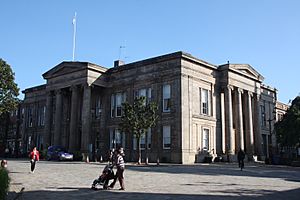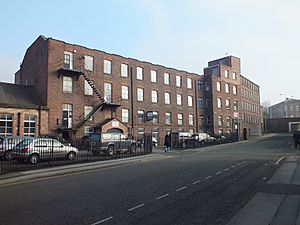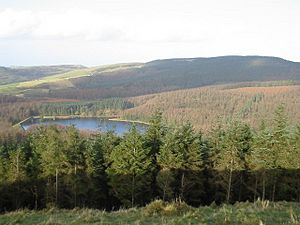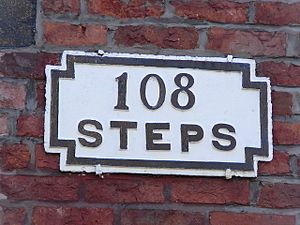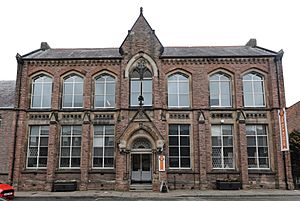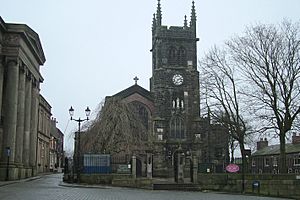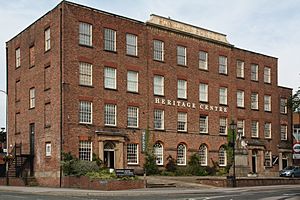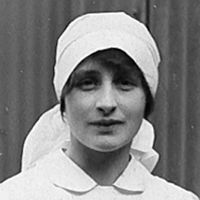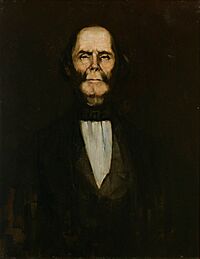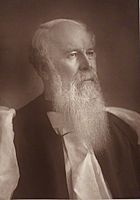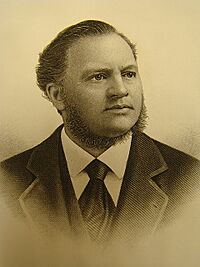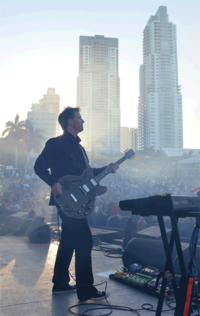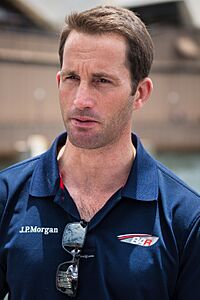Macclesfield facts for kids
Quick facts for kids Macclesfield |
|
|---|---|
| Town | |
 Skyline of Macclesfield, with the railway station in the foreground, the spire of St Paul's Church in the background and townscape |
|
| Population | 57,539 |
| OS grid reference | SJ9173 |
| • London | 148 mi (238 km) SE |
| Civil parish |
|
| Unitary authority |
|
| Ceremonial county | |
| Region | |
| Country | England |
| Sovereign state | United Kingdom |
| Post town | MACCLESFIELD |
| Postcode district | SK10, SK11 |
| Dialling code | 01625 |
| Police | Cheshire |
| Fire | Cheshire |
| Ambulance | North West |
| EU Parliament | North West England |
| UK Parliament |
|
Macclesfield (/mækəlzfiəld/) is a market town in Cheshire, England. It is located by the River Bollin and on the edge of the Cheshire Plain. To its east is Macclesfield Forest. The town is about 16 miles (26 km) south of Manchester and 38 miles (61 km) east of Chester.
Long ago, before the Norman Conquest, Macclesfield was owned by Edwin, Earl of Mercia. The town grew on a hilltop around what is now St Michael's Church. In 1261, Edward I gave it a special charter, allowing it to hold a market and fair. Macclesfield Grammar School was started in 1502.
Macclesfield became famous for making silk. It had a silk-button industry from the 1600s. By the mid-1700s, it was a major silk-making centre. The Macclesfield Canal was built between 1826 and 1831.
Later, the Hovis breadmakers also had a factory here. Today, industries include pharmaceuticals, like Astra Zeneca. Many old mill buildings still stand. Several of the town's museums teach about the local silk history. Other important buildings include the Town Hall and the old Macclesfield Sunday School. St Alban's Church was designed by Augustus Pugin. The Arighi Bianchi furniture shop is also a well-known landmark.
In 2021, Macclesfield had a population of 57,539 people. Someone from Macclesfield is sometimes called a Maxonian.
Contents
- What's in a Name?
- A Look Back at Macclesfield's History
- How Macclesfield is Governed
- Where is Macclesfield?
- Important Landmarks
- What Macclesfield Makes and Sells
- Getting Around Macclesfield
- Culture and Arts
- Local Media
- Schools in Macclesfield
- Places of Worship
- Sports and Fun Activities
- Famous People from Macclesfield
- Sister Cities
- Freedom of the Town
- See also
What's in a Name?
The town's name, "Macclesfield," comes from old English words. It means "Maccel's open country." Maccel was likely a person's name.
Macclesfield is often called "Silk Town" because of its history. But its traditional nickname is "Treacle Town." This nickname comes from a funny story. Once, a horse-drawn wagon carrying treacle (a type of syrup) overturned. The treacle spilled all over the street. People who were poor came and scooped it up from the road.
A Look Back at Macclesfield's History
Early Days and Norman Times
Before the Normans arrived in 1066, Edwin, Earl of Mercia owned Macclesfield. The Normans caused a lot of damage in 1070. By 1086, the area had not fully recovered. Hugh d'Avranches, Earl of Chester took over the manor. A Norman castle was built in Macclesfield.
In the early 1200s, Ranulf de Blondeville, 6th Earl of Chester gave Macclesfield a special borough charter. This helped the town grow. In 1261, the future King Edward I gave another charter. This allowed the town to have a market, a fair, and a court.
The medieval town was built on a hilltop. It centered around All Saints parish church, built in 1278. In 1357, a hall was built for the mayor's court. At this time, Macclesfield was a small market town. It did not have many industries and was considered poor. Its population was only a few hundred people.
Cheshire Archers and Local Markets
The Cheshire archers were skilled soldiers. They were known for using the longbow. These archers fought in many famous battles, like Agincourt and Crecy. In 1277, Edward I chose 100 archers from the Macclesfield area to be his personal bodyguards. Later, Richard II also had a bodyguard of these archers.
Macclesfield had a weekly market and two yearly fairs. One fair was called the Barnaby fair. Today, the Barnaby fair has become the Barnaby Festival. This is a cultural event held in mid-June. The weekly market no longer happens. But on the last Sunday of each month, the Treacle Market is held. This market sells local food and handmade items.
Macclesfield was the main administrative center for the Hundred of Macclesfield. This area covered most of east Cheshire. The Earl of Chester's manor of Macclesfield was very large. It included the Macclesfield Forest, which was much bigger than it is today. The forest was used for hunting deer and grazing animals.
Macclesfield Castle was a fortified house. It was built by John de Macclesfield starting in 1398. In 1502, Macclesfield Grammar School was founded by Sir John Percyvale.
Town Growth and Civil War
There is no proof that Macclesfield was ever a walled town. However, it likely had a ditch and a fence on its western side. This was to keep out unwanted people and animals. The word "Gate" in some street names, like Chestergate, means "road." It does not mean a gate in a wall.
By the Tudor period, Macclesfield was doing well. It made harnesses, gloves, and especially buttons. Later, it also made ribbons and tapes. Coal mining started in the 1500s. In 1664, the population was about 2,600. This made Macclesfield the third-largest town in Cheshire. The town grew quickly throughout the 1700s. By 1801, its population reached 8,743.
Macclesfield was an early center for Puritan and Quakers religious groups. By 1718, about 10% of the people were Nonconformists. Later, the town had a large Methodist community. Christ Church was the only Anglican church in the county to invite John Wesley to preach.
During the English Civil War, in 1642, Sir Thomas Aston took over the town for the King. In the Jacobite Rising of 1745, Charles Stuart and his army marched through Macclesfield. They were trying to reach London. The mayor had to welcome the prince. This event is remembered in one of the town's silk tapestries. Cumberland House on Jordangate is named after the Duke of Cumberland. He stayed there in 1745 while chasing the prince.
By 1841, the population had grown to 24,137.
Macclesfield's Industries
Macclesfield was once the world's largest maker of finished silk. A button-making industry started in the town by the mid-1500s. The first mention of silk buttons was in 1649. In the mid-1700s, silk buttons went out of style. So, the industry changed to making silk fabric in mills. Macclesfield's first silk mill was started by Charles Roe in 1743 or 1744. The mills first used water power, then steam power.
In 1832, there were 71 silk mills. They employed 10,000 people. But in 1851, the industry faced problems. Many mill workers moved to Paterson, New Jersey, in America. The silk industry continued in Macclesfield into the 1980s. However, it was no longer the main industry. Paradise Mill reopened in 1984 as a working museum. It shows how silk was made and woven. The four Macclesfield Museums have lots of information and products from this time.
Charles Roe also started a short-lived copper-smelting business in 1750. It processed ore from nearby mines. Later, it switched to making brass. The business closed after Roe's death in 1781. Some street names in the town still show this history.
The Macclesfield Canal was built between 1826 and 1831. It connected Macclesfield to Marple in the north and Kidsgrove in the south. The canal was designed by Thomas Telford. It was one of the last narrow canals built. It was not very successful because trains soon took over transporting coal and other goods.

Macclesfield is where Hovis breadmakers started. Their mill was on the canal. Hovis bread was created to be a cheap and healthy food for poor mill workers. The name Hovis is said to come from Latin words meaning "strength for man."
Waters Green used to be a famous horse market. It is part of the legend of the Wizard of Alderley Edge. Waters Green also had a sheep and cattle market until the 1980s.
Macclesfield is said to be the only mill town not bombed in World War II. After the war, two pharmaceutical companies opened factories here. These were Geigy (now part of Novartis) and ICI (now AstraZeneca).
How Macclesfield is Governed
Macclesfield first had Members of Parliament (MPs) in 1832. It had two MPs until 1880. After some problems with the election that year, the town lost its MPs for a while. In 1885, the Macclesfield constituency was brought back. Since then, it has elected one MP.
For a long time, Macclesfield was a very safe seat for the Conservative Party. They held it since 1918. However, the 2017 election showed a big shift away from the Conservatives.
Currently, Tim Roca of the Labour party represents Macclesfield. He was elected in the 2024 general election. Before him, David Rutley was the MP.
Macclesfield used to be governed by the Macclesfield Municipal Borough. In 2009, Cheshire East Council was formed. In 2015, Macclesfield Town Council was created. The Labour Party controls Macclesfield Town Council.
Macclesfield also has 12 councillors on the larger Cheshire East Council. Nine of these are Labour, and three are Independents.
Where is Macclesfield?
Macclesfield is in the east of Cheshire. It is on the River Bollin, which flows into the River Mersey. It is close to the borders of Greater Manchester (north), Derbyshire (east), and Staffordshire (south). Nearby towns include Stockport (north), Buxton (east), and Congleton (south). It is 38 miles (61 km) east of Chester, which is the county town of Cheshire.
To the west of Macclesfield is the flat Cheshire Plain. To the east is Macclesfield Forest. This forest has Ridgegate and Trentabank Reservoirs. These reservoirs provide drinking water for the town. Tegg's Nose and the Peak District are also nearby.
The Macclesfield Built-up Area includes the town itself, Bollington, and Prestbury. This urban area has a population of 63,954.
In 2011, the population of the urban area was 31,266 males and 32,688 females. Most people (over 96.2%) were white. About 66.3% of people were Christian. About 24.8% said they had no religion.
 |
Prestbury | Poynton | Peak District – Whaley Bridge |  |
| Chelford | Peak District – Buxton | |||
| Congleton | Leek | Peak District |
Macclesfield's Weather
Macclesfield has a mild maritime climate. This means it has cool summers and mild winters. Records of the weather go back to at least 1850. The highest temperature recorded between 1881 and 2005 was 33.1 °C (91.6 °F) on August 3, 1990. The lowest was −16.7 °C (1.9 °F) on December 25, 1860.
Important Landmarks
The town is famous for its past silk industry. You can learn about it at the Silk Museum.
The Georgian style Town Hall was designed by Francis Goodwin in 1823.
Macclesfield has a church designed by Augustus Pugin. It is St Alban's on Chester Road.
The old Cheshire County Asylum is now apartments. It was designed by Robert Griffiths in an Italian style.
What Macclesfield Makes and Sells
Macclesfield is home to AstraZeneca, one of the world's largest pharmaceutical companies. The furniture store Arighi Bianchi started in 1829. Other industries in town include textiles, light engineering, paper, and plastics.
Getting Around Macclesfield
By Train
Macclesfield station is on the main train line from Stafford to Manchester. Three train companies serve the station:
- Avanti West Coast runs trains every hour. These go to Manchester Piccadilly (20 minutes away), Stockport (10 minutes), Stoke-on-Trent (15 minutes), and London Euston (1 hour 47 minutes).
- CrossCountry runs hourly trains to Manchester Piccadilly, Stockport, Birmingham New Street, Reading, Southampton Central, and Bournemouth.
- Northern Trains provides an hourly local service. These trains stop at Manchester Piccadilly, Stockport, Congleton, and Stoke-on-Trent.
The first railway station opened in 1849. The current station was built in the mid-1960s.
By Bus
Macclesfield has a bus station in the town center. The current bus station opened in 2004.
The main bus companies are D&G Bus and High Peak Buses. There are fifteen bus routes. They go within the town and to other places like Altrincham, Buxton, Congleton, Crewe, Knutsford, Stockport, Wilmslow, and Wythenshawe. Only two services run on Sundays.
By Road
Macclesfield has good road connections from the north, south, and west. However, there are fewer roads to the east because of the Peak District mountains.
From the south, you can get to Macclesfield from Congleton and the Potteries using the A536. The A523 comes from Leek. From the north, the main road is the A523 from Manchester, Hazel Grove, and Poynton. The main west-east road is the A537 from Knutsford to Buxton. Some of these roads combine in the town center, which can cause traffic jams. The A538 goes to Prestbury, Wilmslow, and Manchester Airport. The B5470 is another eastbound route, heading to Whaley Bridge and Chapel-en-le-Frith.
Culture and Arts
In 2004, a study said Macclesfield was one of the least "cultured" towns in Britain. This was based on its lack of theaters and cinemas.
The Northern Chamber Orchestra is the oldest professional music group in the North West. It performs at the Macclesfield Heritage Centre.
Macclesfield now has one main museum: the Silk Museum on Park Lane. You can also visit Paradise Mill, an old silk mill. The Silk Museum also has ancient Egyptian items. These were brought back by Marianne Brocklehurst and Mary Booth.
Macclesfield Chess Club is one of the oldest in the country. It started in 1886.
The 'Macclesfield Literary and Philosophical Society' was formed in 2006. It was partly a response to the 2004 article about the town's culture.
Local newspapers include the Macclesfield Express. Macclesfield also has online message boards for local news. Two local radio stations are Canalside Community Radio and Cheshire's Silk Radio.
The last commercial cinema in Macclesfield closed in 1997. However, a small cinema called Cinemac opened in the Heritage Centre in 2005. The Silk Screen arts cinema also shows art-house films there.
Amateur dramatics are popular. The Macclesfield Amateur Dramatic Society started in 1947. They perform in their own theater on Lord Street. The Macclesfield Majestic Theatre Group has been putting on musicals since 1971. Some members of this group have become professional actors.
Gawsworth Hall hosts a yearly Shakespeare festival. It also has many other arts and music events.
Macclesfield has been used in films. It was a location for the 1947 film So Well Remembered. A fictional version of Macclesfield's railway station appeared in the 2005 film Green Street. The 2007 film Control, about Ian Curtis of Joy Division, was also filmed here.
The blues singer John Mayall was born in Macclesfield in 1933. Ian Curtis and Stephen Morris of Joy Division were from Macclesfield. Gillian Gilbert, also from New Order, is from here too. A memorial to Ian Curtis is at Macclesfield Crematorium. Other bands from Macclesfield include The Macc Lads and Marion.
The Silk Brass Band from Macclesfield won a national championship in 2002. The local band The Virginmarys has gained national and international success. The chart-topping UK band The 1975 also comes from Macclesfield.
In books, Macclesfield is a main location in the fantasy novels The Weirdstone of Brisingamen and The Moon of Gomrath by Alan Garner.
In 2008, a study found that Macclesfield was the fifth happiest district in Britain.
Local Media
Local news and TV shows come from BBC North West and ITV Granada.
The town is served by BBC Radio Manchester and BBC Radio Stoke. Other radio stations include Heart North West and Smooth North West. Community radio stations are Silk Radio and Canalside Radio.
The Macclesfield Express is the town's local newspaper. It is published on Wednesdays.
Schools in Macclesfield
Macclesfield has four state-funded academies (high schools): Tytherington School, The Macclesfield Academy, Fallibroome Academy, and All Hallows Catholic College.
There is also an independent school called Beech Hall School.
The Macclesfield Academy includes students from the former Henbury High School. It also took in students when Ryles Park secondary school closed in 2004. The Macclesfield Academy is part of the Macclesfield 'Learning Zone', which opened in 2007.
Places of Worship
The hilltop church of St Michael and All Angels offers views of nearby Kerridge Hill. You can reach the church from Waters Green by climbing 108 steps. These steps are a local landmark.
Macclesfield Sunday School started in 1796. It was a school for 40 children. It aimed to help poor children learn. In 1812, a special school building was built on Roe Street. This "Big Sunday School" had over 2,400 children enrolled when it opened.
St Alban's Church on Chester Road is an active Roman Catholic church. It is a very important historic building. It was designed by A. W. N. Pugin.
Christ Church is an old Anglican church made of brick. It is also a very important historic building. The church was used until 1981. It is still used for services sometimes.
There is a Mormon church on Victoria Road.
Other churches with interesting architecture include:
- King Edward Street Chapel, Macclesfield
- St George's Church, Macclesfield
- St Paul's Church, Macclesfield
- St Peter's Church, Macclesfield
- Holy Trinity Church, Hurdsfield
- Macclesfield United Reformed Church
Sports and Fun Activities
Football
Macclesfield's professional football club was Macclesfield Town. They joined the Football League in 1997. They had won the Football Conference title two years earlier. But they couldn't be promoted then because their stadium, Moss Rose, was not big enough. After the 2019–20 season, they were moved down from EFL League Two. In September 2020, Macclesfield Town Football Club closed down because of debts.
Macclesfield F.C.
On October 13, 2020, a new club was formed. It bought the assets of the old club. This new club is called Macclesfield F.C.. They currently play in the Northern Premier League (Premier Division).
Other Football Clubs
Youth football teams include Macclesfield Juniors FC and Macclesfield Saints JFC.
Other Sports
Macclesfield RUFC is the town's rugby union club. They play in National League 1.
Macclesfield Wheelers is a local cycling club. It offers activities from fun rides to racing. Famous cyclist Reg Harris made his bikes in Macclesfield in the 1960s. MaccBUG is a local group that works for better cycling paths.
Macclesfield Harriers & Athletic Club is a very active club. It has over 500 members of all ages and abilities. They have sections for road running, track & field, fell running, and cross country.
Macclesfield Hockey Club is a community club. It has 8 senior teams and a growing junior section. They welcome players of all skill levels from age 5 and up.
In 2006, a survey found that Macclesfield residents were very active in sports. About 29.3% of the population exercised at least three times a week.
Macclesfield parkrun is a free 5k run. It happens every Saturday morning at 9:00 am in South Park.
Famous People from Macclesfield
Politicians
- John Brocklehurst (1788–1870) – A silk producer and MP for Macclesfield for 36 years.
- William Coare Brocklehurst (1818–1900) – John's son and also an MP.
- William Brocklehurst Brocklehurst (1851–1929) – A businessman and MP for Macclesfield from 1906 to 1918.
Public Service
- John Shert (c.1544–1582) – A Catholic priest who was executed and later recognized as a martyr.
- William Buckley (1780–1856) – An escaped convict who lived among Australian aborigines for many years.
- John Charles Ryle (1816–1900) – The first Anglican Bishop of Liverpool.
- Arthur Smith Woodward (1864–1944) – A scientist who studied fossil fish.
- Vera Brittain (1893–1970) – A nurse, writer, and pacifist who lived in Macclesfield as a child.
- Edward Brittain (1895–1918) – A British Army officer who fought in World War I. His sister Vera Brittain wrote about him.
Business Leaders
- Charles Roe (1715–1781) – An industrialist who helped start the silk industry in Macclesfield.
- James Pigot (1769–1843) – A publisher who created early business directories.
- Sir Thomas Wardle (1831–1909) – A businessman known for new ways of dyeing and printing silk.
Artists and Performers
- Kika Markham (born 1940) – An English actress.
- Sarah Burton (born 1974) – A fashion designer and creative director for Alexander McQueen.
- Helen Marten (born 1985) – A sculptor who won the Turner Prize.
Journalists and Writers
- Brian Redhead (1929–1993) – A journalist for the Manchester Guardian and BBC Radio 4.
- Sir Andreas Whittam Smith (born 1937) – A financial journalist who founded The Independent newspaper.
- Nick Robinson (born 1963) – A political editor for the BBC and now a radio presenter.
Musicians
- John Mayall (1933–2024) – A famous blues musician and bandleader.
- Noddy Holder (born 1946) – The lead singer of the band Slade, who lives in Macclesfield.
- Ian Curtis (1956–1980) – The lead singer of the band Joy Division.
- Stephen Morris (born 1957) – The drummer for Joy Division and New Order.
- Gillian Gilbert (born 1961) – A musician and member of New Order.
- Andy Carthy (born 1972) – Known as Mr. Scruff, a record producer and DJ.
- Phil Cunningham (born 1974) – A guitarist for the bands Marion and New Order.
- Hatty Keane (born 1994) – An R&B and pop singer.
TV Personalities
- Dominic Brunt (born 1970) – An actor who played Paddy Kirk in the TV show Emmerdale.
- Geoff Lloyd (born 1973) – A radio DJ.
- Marshall Lancaster (born 1974) – An actor who played Chris Skelton in the BBC dramas Life on Mars and Ashes to Ashes.
Sports Stars
- Reg Harris (1920–1992) – A famous track cyclist.
- Guy Edwards (born 1942) – A former Formula One racing driver.
- Jonathan Agnew (born 1960) – A cricketer and cricket commentator.
- Peter Moores (born 1962) – A former England Cricket Coach.
- Jamie Donaldson (born 1975) – A golfer.
- Sir Ben Ainslie (born 1977) – An Olympic gold medal-winning yachtsman.
- Peter Crouch (born 1981) – An England international football player.
- Izzy Christiansen (born 1991) – An English women's footballer.
- Emily Whitlock (born 1994) – A professional squash player.
Sister Cities
Macclesfield does not have any official sister cities. However, until 2010, it had a friendly connection with Eckernförde in Germany. This started after World War II when people from Macclesfield sent aid to Eckernförde.
Freedom of the Town
Some people and military groups have been given the special "Freedom of the Town" of Macclesfield.
Individuals
- Sir Geo Jeffreys: 1682.
- John Askey: August 9, 2018.
Military Regiments
- 4th Battalion The Cheshire Regiment: 1902.
See also
 In Spanish: Macclesfield para niños
In Spanish: Macclesfield para niños



